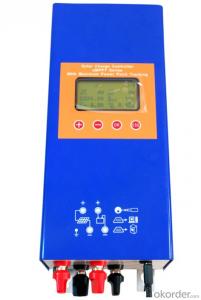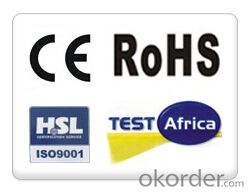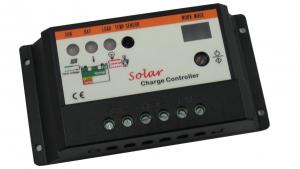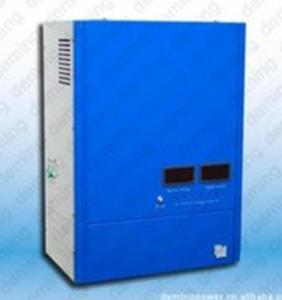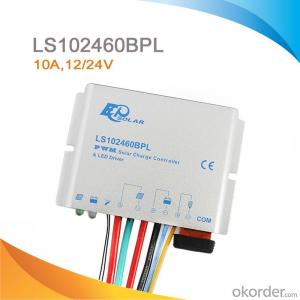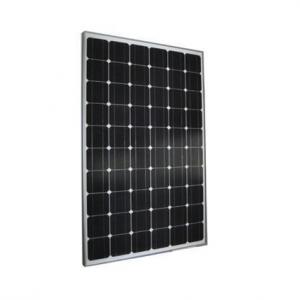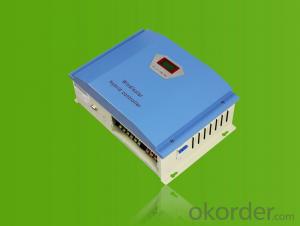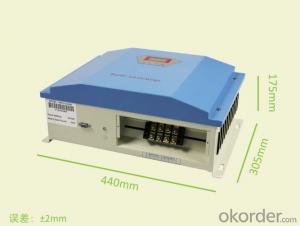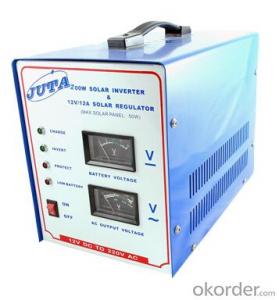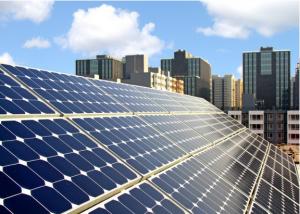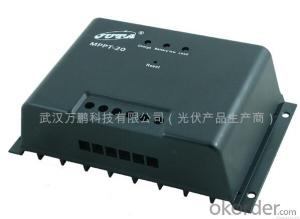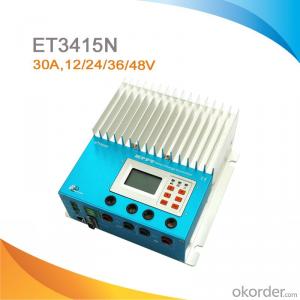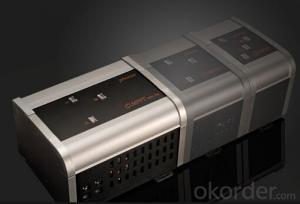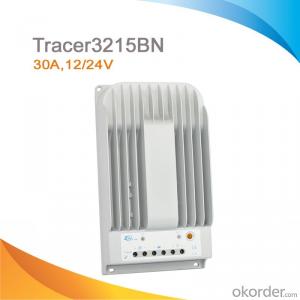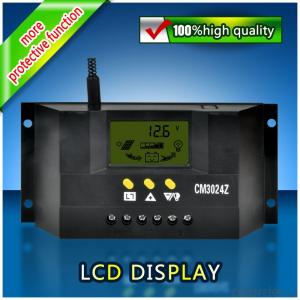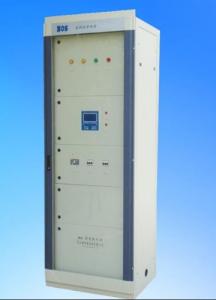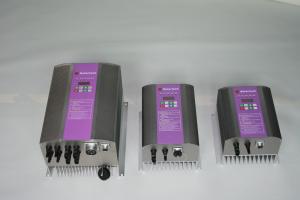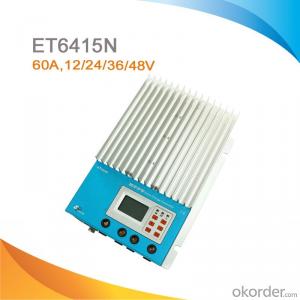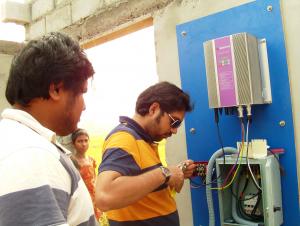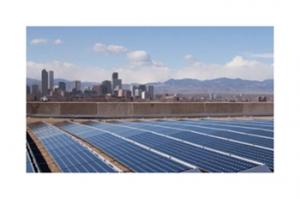Solar Controller for Tracking Maximum Power Model eMPPT 3024Z
- Loading Port:
- Shanghai
- Payment Terms:
- TT OR LC
- Min Order Qty:
- 5 unit
- Supply Capability:
- 30 unit/month
OKorder Service Pledge
OKorder Financial Service
You Might Also Like
1. Structure of Solar Controller for Tracking Maximum Power Model eMPPT 3024Z
The Solar Controller eMPPT 3024Z can be used in home system, and it benefits from DC/DC converter technique and MCU technique, which have capacity to adjust the operation spot of the solar modules so as to reach the maximum power output of the solar modules. The MCU of controller of Series eMPPT can intelligently track the operation spot of the solar modules by the algorithm MPPT, so the use ratio of solar modules can be raised and therefor the cost of the solar generating system can be reduced. Compare to the ordinary solar charging controller, eMPPT controller can in general increase the power output of the solar modules by 5% at least and 30% at most(the own characteristics of solar modules, temperature and illumination etc. have effect on how to raise the percentage of the power output ).
2. Main Features of Solar Controller for Tracking Maximum Power Model eMPPT 3024Z
Dot matrix large screen and LCD showing all parameters
Vivid icon indicating the concept of all parameters
Nice interface and clear for observation
Whole device for wall mounting type to install
3. Solar Controller for Tracking Maximum Power Model eMPPT 3024Z Images

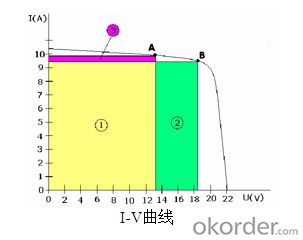
4. Solar Controller Model for Tracking Maximum Power eMPPT 3024Z Specification
Mode | eMPPT3024Z | |
Input | Solar Module Input Voltage Scope | ≤70V |
Maximum Power Spot Tracking Voltage Scope | 12V~70V(12V) | |
24V~70V(24V) | ||
Solar Module Input Circuit | Circuit 1 | |
Output | Rated Working Voltage | 12V/24V(Automatic Identification) |
Max. Charging Current | 30A | |
Stand-by loss | ≤30mA | |
Charging Mode | Three phases for charging control(Bulk、Absorption、Float) | |
Floating Charge Voltage | 27.6V(adjustable) | |
Temperature compensation for Floating Charge Voltage | -4mV/cell/℃ | |
Absorption Charging Voltage | 28.8V(adjustable) | |
Range of Temperature measurement | -20℃~+70℃ |
5. FAQ
We have organized several common questions for our clients, which may help you sincerely:
1) How to guarantee the quality of the products?
The company is approved by the ISO9000 quality management system with its strict product quality control. The products for exportation pass the inspection of relevant foreign nations (CE, ROHS), and get high evaluation of the customers.
2) How long can we receive the product after signing Sales Confirmation?
Generally speaking, if there is enough quantity of finished products which can meet the clients’ requirement, we can manage the delivery within three to five working days according to the instruction of the payment terms in the Sales Confirmation; if the products needs some time to get ready, we will arrange the delivery as soon as possible after the manufacture.
- Q: Can a solar controller be used with a solar-powered electric vehicle charging station network?
- Yes, a solar controller can be used with a solar-powered electric vehicle charging station network. A solar controller helps regulate the flow of electricity from the solar panels to the charging stations, ensuring that the energy generated by the solar panels is efficiently utilized for charging electric vehicles. It monitors and optimizes the charging process, protects the batteries from overcharging, and helps manage the overall performance of the charging station network.
- Q: Can a solar controller be used with a solar-powered electric vehicle charging station?
- Yes, a solar controller can be used with a solar-powered electric vehicle charging station. The solar controller regulates and optimizes the power output from the solar panels to charge the electric vehicle's batteries efficiently. It ensures that the charging station receives the appropriate voltage and current from the solar panels, thereby maximizing the charging performance and minimizing any potential damage to the batteries.
- Q: Can a solar controller handle both 12V and 24V systems?
- Yes, a solar controller can handle both 12V and 24V systems. Most solar controllers are designed to be compatible with both voltage systems and can automatically adjust the charging settings accordingly.
- Q: Can a solar controller be used in a mobile solar power system, such as an RV or boat?
- Yes, a solar controller can definitely be used in a mobile solar power system such as an RV or boat. In fact, it is highly recommended to use a solar controller in these setups to regulate and optimize the charging of the batteries. The solar controller helps prevent overcharging, protects the batteries from damage, and ensures efficient power generation from the solar panels.
- Q: What is the maximum current rating of a solar controller?
- The maximum current rating of a solar controller can vary depending on the model and manufacturer. However, common solar controllers typically have maximum current ratings ranging from 10 to 60 amps.
- Q: How does a solar controller prevent damage from reverse polarity connections?
- A solar controller prevents damage from reverse polarity connections by utilizing built-in protection mechanisms that detect and block the flow of current when the positive and negative terminals are incorrectly connected. This prevents any potential damage to the solar panels, batteries, or other connected devices, ensuring the system remains safe and functional.
- Q: Can a solar controller be used with a solar water pump?
- Yes, a solar controller can be used with a solar water pump. A solar controller is designed to regulate and optimize the charging of batteries from solar panels. It can also be used to control the operation of a solar water pump, ensuring efficient use of solar energy and preventing overcharging or damage to the pump.
- Q: Can a solar controller be used in a hybrid solar panel system?
- Yes, a solar controller can be used in a hybrid solar panel system. A solar controller, also known as a charge controller, is responsible for regulating the voltage and current from the solar panels to the batteries or grid. In a hybrid solar panel system, which combines both solar and other energy sources like wind or grid electricity, a solar controller is still necessary to manage the charge from the solar panels. It helps ensure that the batteries are properly charged and protected from overcharging or excessive discharging. Additionally, a solar controller can also monitor and optimize the energy flow between the different energy sources in a hybrid system, maximizing the efficiency and utilization of the solar power generated.
- Q: Can a solar controller be used with a solar-powered satellite navigation system?
- Yes, a solar controller can be used with a solar-powered satellite navigation system. A solar controller, also known as a charge controller, is a device that regulates the flow of electricity from the solar panels to the batteries, ensuring they are charged efficiently and preventing overcharging. In a solar-powered satellite navigation system, solar panels are used to generate electricity from the sun's energy. This electricity is then stored in batteries for use when the sunlight is not available, such as during nighttime or in cloudy weather conditions. A solar controller plays a crucial role in this system by managing the charging process of the batteries. It monitors the voltage and current from the solar panels and adjusts the charging rate to prevent overcharging, which can damage the batteries. Additionally, it helps optimize the charging efficiency by maintaining the batteries at their optimal charge level. By using a solar controller, the solar-powered satellite navigation system can effectively harness the sun's energy and ensure the batteries are properly charged, maximizing the system's performance and longevity.
- Q: Can a solar controller be used with solar panels that are connected to a battery management system?
- Yes, a solar controller can be used with solar panels that are connected to a battery management system. The solar controller helps regulate the charging of the batteries by adjusting the voltage and current from the solar panels to ensure optimal charging and prevent overcharging. This helps prolong the lifespan of the batteries and ensures efficient utilization of solar energy.
Send your message to us
Solar Controller for Tracking Maximum Power Model eMPPT 3024Z
- Loading Port:
- Shanghai
- Payment Terms:
- TT OR LC
- Min Order Qty:
- 5 unit
- Supply Capability:
- 30 unit/month
OKorder Service Pledge
OKorder Financial Service
Similar products
Hot products
Hot Searches
Related keywords
